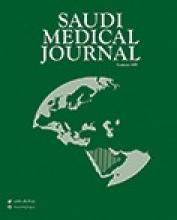REVIEW ARTICLE
Middle East respiratory syndrome in children. Dental considerations
Al-Sehaibany consider the unique work environment of dentists, which involves close patient contact and aerosol production, the risk of Middle East Respiratory Syndrome Coronavirus (MERS-CoV) transmission from an infected patient is high. Children are also prone to MERS-CoV infection. As the number of MERS-CoV cases may increase in future, pediatric dentists should be well informed and educated about not only the signs and symptoms of the condition but also how to follow stringent infection control measures in these cases. In this review, Al-Sehaibany discusses Middle East Respiratory Syndrome Coronavirus (MERS-CoV) infection among children and those providing dental treatment, including precautions and considerations pertaining to the practice of pediatric dentistry.
see page 339
ORIGINAL ARTICLES
ABO blood groups and risk of deep venous thromboembolism in Chinese Han population from Chaoshan region in South China
Yu et al conclude that there is a higher risk of venous thromboembolism in non-O blood groups than O group. Of 89 patients with deep venous thromboembolism, 28 patients had blood group A (31.5%), 28 patients had blood group B (31.5%), 13 patients had blood group AB (14.6%), and 20 patients had blood group O (22.5%). Compared with O blood type, the odds ratios of deep venous thromboembolism for A, B and AB were 2.23 (95% CI, 1.27-3.91), 2.34 (95% CI, 1.34-4.09) and 4.43 (95% CI, 2.24-8.76).
Primary characteristics of patients with deep venous thromboembolism
see page 396
Prevalence of apical periodontitis and quality of root canal treatment in an adult Saudi population
Al-Nazhan et al conclude that apical periodontitis was significantly related to diabetes, smoking, and inadequate endodontic treatment. Of the 25,028 teeth examined, 1,556 teeth (6.2%) had apical periodontitis (AP). Male subjects aged over 55 years and females between 36 and 45 years had higher AP. A total of 36 diabetic and 87 smokers subjects had AP. The AP was more common in male diabetics than female (p=0.383), and in female smokers more than male (p=0.44). Only 42.2% of male and 57.7% of female teeth had adequate root canal treatment.
Distribution of assessed teeth, root canal treated teeth (RCT), and teeth with apical periodontitis (AP) by gender
see page 413
CASE REPORT
Staged closure of a giant omphalocele with amnion preservation, modified technique
Aljahdali et al describe 2 cases of giant omphalocele treated with a modified amnion preservation, staged closure technique. This paper demonstrates the feasibility and safety of this technique, and the versatility of amnion to adapt to an escharization strategy if closure is not achievable. They observed that the potential benefits of amnion preservation far outweigh the risks, and advocate for its routine use in cases of giant omphalocele. Attention should be given to expeditious visceral reduction, as long as the infant can tolerate it physiologically. In the event that reduction cannot be tolerated, or if the silo detaches from the fascia, amnion preservation allows the flexibility of switching to an escharization approach.
Picture of day one of life showing the giant omphalocele, containing liver and bowel
see page 422
- Copyright: © Saudi Medical Journal
This is an open-access article distributed under the terms of the Creative Commons Attribution-Noncommercial-Share Alike 3.0 Unported, which permits unrestricted use, distribution, and reproduction in any medium, provided the original work is properly cited.









